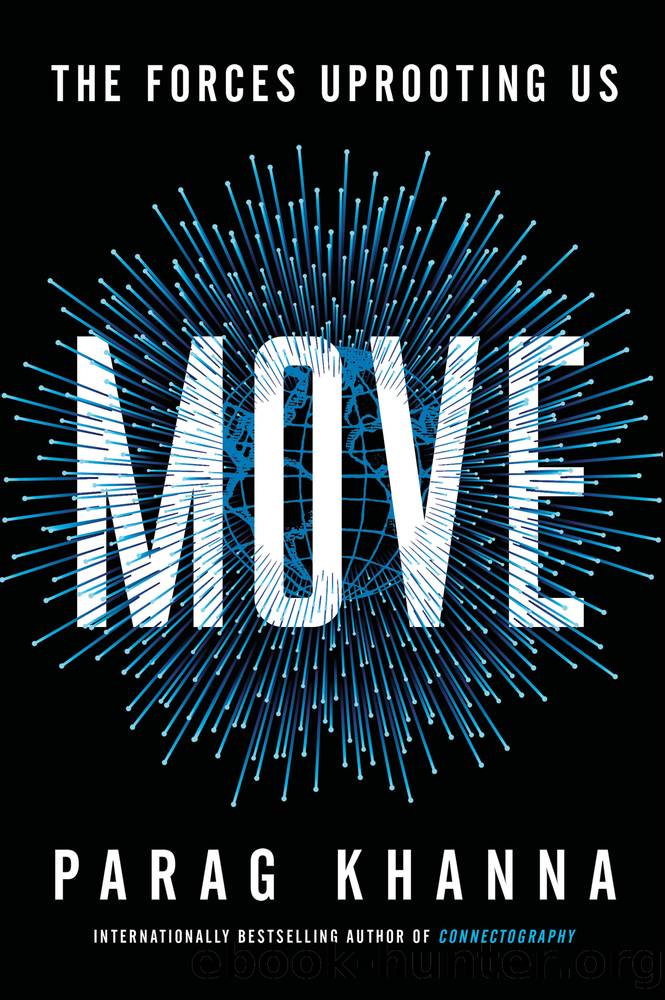Move by Parag Khanna

Author:Parag Khanna
Language: eng
Format: epub
Publisher: Scribner
Published: 2021-10-12T00:00:00+00:00
CHAPTER 7 NORTHISM
Continental cousins
More than three-quarters of the world population live in the northern hemisphere, with just over 500 million in North America and just over 5 billion in Eurasia. The North is also home to all the powerful states in the world, those with size and resources as well as the capacity to harness them and absorb more people. The North American and Eurasian continents are therefore both the historical and future seats of demographics and geopolitics. In the nineteenth and twentieth centuries, European technology and emigrants helped North America catch up in wealth, with the US alone representing half the world economy at the end of World War II. But with both the European and Asian ends of Eurasia far larger than North America in population, while achieving parity in wealth and technology, North Americaâs share of the global economy has dropped to 15 percent.
North Americaâs advantage nonetheless lies in its strategic stability and manageable population size. Though its three major countries have tensions over industrial policies and immigration, the US trades more with both Canada and Mexico than it does with China, and the US is also by far the largest investor in both countries. The continentâs two major borders are symbolically potent, but the countriesâ deep complementarities in energy, agriculture, and industry are far more significant. The American regions most resilient to climate change, such as the Rockies, the Great Plains, and the Great Lakes, are all geographical and topological zones the US shares with Canadaâfurther underscoring the inevitability of a more integrated North American Union.
Americaâs demographic blending with Mexico also belies the notion of an impenetrable border fence. There are already 37 million Mexican-Americans, and dual citizens comprise an ever larger binational community populating towns across California, Arizona, New Mexico, and Texas. El Paso and Juárez are joined by a bridge across the border, with thousands moving north daily for school, shopping, or to give birth, or south to visit family or for cheap medical care. With retirees and younger Americans alike seeking a cheaper lifestyle, the number of âAmerican-Mexicansâ living in Mexico has ballooned from just two hundred thousand twenty years ago to 1.5 million today.1 In the decades ahead, climate migrants from Central America may become a northward swell that dwarfs anything seen to date.2
Leading geography scholar Alec Murphy of the University of Oregon argues that the movement of people over time alters the grand narrative we associate with each region of the world. In this way, human geography allows us to investigate deep questions such as: What role will North America and its population play in a complex planetary society amid accelerating climate change?
We must explore the future of Eurasia with the same weighty agenda. Eurasiaâs rediscovery of the medieval Silk Roads has been accelerating over the past three decades, since the collapse of the Soviet Union. In the 1990s I began taking European trains south into the Balkans and watching the EU expand eastward toward Russia, and its influence reach the Caucasus countries by the Caspian Sea.
Download
This site does not store any files on its server. We only index and link to content provided by other sites. Please contact the content providers to delete copyright contents if any and email us, we'll remove relevant links or contents immediately.
Zero to IPO: Over $1 Trillion of Actionable Advice from the World's Most Successful Entrepreneurs by Frederic Kerrest(4293)
Machine Learning at Scale with H2O by Gregory Keys | David Whiting(4179)
Never by Ken Follett(3790)
Harry Potter and the Goblet Of Fire by J.K. Rowling(3774)
Ogilvy on Advertising by David Ogilvy(3510)
Shadow of Night by Deborah Harkness(3302)
The Man Who Died Twice by Richard Osman(2997)
Book of Life by Deborah Harkness(2867)
The Tipping Point by Malcolm Gladwell(2827)
Will by Will Smith(2792)
0041152001443424520 .pdf by Unknown(2784)
My Brilliant Friend by Elena Ferrante(2774)
How Proust Can Change Your Life by Alain De Botton(2742)
Purple Hibiscus by Chimamanda Ngozi Adichie(2652)
How to Pay Zero Taxes, 2018 by Jeff A. Schnepper(2602)
Hooked: A Dark, Contemporary Romance (Never After Series) by Emily McIntire(2500)
Rationality by Steven Pinker(2291)
Borders by unknow(2227)
Can't Hurt Me: Master Your Mind and Defy the Odds - Clean Edition by David Goggins(2226)
